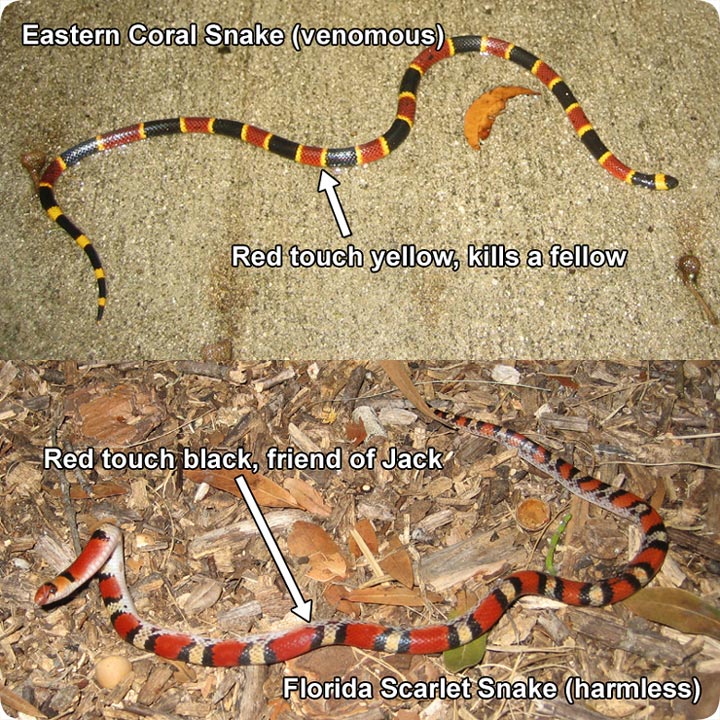-
info@aaanimalcontrol.com
Call us for help in your town
Humane Wildlife Education
Red Touch Yellow, Kills a Fellow. Red Touch Black, Friend of Jack.

There's one little glitch, however. Though the mimic snakes have a similar size and shape, and the same Red-Black-Yellow color scheme, the order of the pattern is off. For some reason, most of the mimics, which probably started out as striped snakes of a kind, have black bands every other color. The coral snake is the only one that has alternating yellow bands. Thus, with the Coral snake, the red band touches the yellow band, and with the mimics, the red band touches the black band. In order to help folk remember, a man named "Fat" Jack Loticus developed the rhyme in 1862. There are a few different variations shown below, and the first is the original, and the others are variations popular in different regions of the country:
Red touches yellow, kills a fellow. Red touches black, friend of Jack
Red touch yellow, kills a fellow. Red touch black, venom lack.
Red touch yellow, death says hello. Black touch red, keep your head.
Yellow touch red, you be dead. Red touch black, eat Cracker Jack.
Red and yellow mingle, bite feel a tingle. Red and black hug, sing a song, you lug.
Red and yellow cohabitate, soon you will suffocate. Red and black together, in for sunny weather.
Red leans on yellow, legs turn to jell-o. Red leans on black, keep a strong back.
Yellow brushes red, snake gets fed. Red brushes black, snake gets no snack.
Snake of black and yellow and red, soon a stupid rhyme is said.
Learn how to tell if any snake is venomous
I learned the rhyme in 7th grade from my biology teacher. He told me the original version by Jack Loticus. However, I've been involved in nuisance wildlife trapping and snake control for many years, and I have heard all
of the above regional variations at one time or another. I suspect that even more exist. The great irony of these mnemonic devices for snake memory is that some people discover a snake, and during the time they take to
carefully jog their memory for the correct rhyme, the snake has often bitten and slithered off, leaving the person standing with furrowed brow, his fate already sealed.
Of course,
the ability to simply identify a snake on sight, without the use of silly rhymes, is a better approach, so just study the appearance of the Coral Snake seen above, and you'll
recognize it if you see it. Many people also know to look for the black nose, which the mimic snakes lack. However, the real best approach when discovering an unknown
snake is to simply leave it alone. Virtually all cases of snakebite occur when people attempt to capture or kill snakes. The Coral Snake in particular is very shy and reclusive, and it has no intention of biting. In
fact, it has a tiny mouth and small fangs, and you have to be pretty careless to get envenomated. So I propose a new rhyme: "Just leave snakes alone, chappy, and everybody goes home happy".
Do it yourself: Visit my How To Get Rid of Snakes page for tips and advice.
Get professional help: Visit my Nationwide Pro Directory of wildlife removal experts.
For more wildlife stories, click my Wildlife Blog
or click my below banner to hire a local trapper.
You can also catch snakes with a special trap, which you can order by clicking this banner:





















